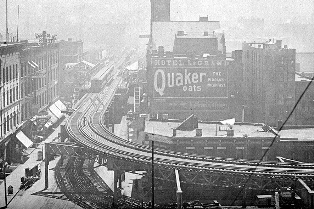Whipping Through the Windy City
June 6, 1892: Chicago’s ‘L’ trains began service. On this date, a small steam locomotive pulled four wooden coaches carrying 27 men and 3 brave women from the 39th Street station and 14 minutes later arrived at the Congress Street Terminal. The tracks are still in use today on the Green Line. By the next year service was extended to 63rd Street and Stony Island Avenue. Also in 1893, service included a stop at the Transportation Building at the World’s Columbian Exposition. Finally, they began running on the Lake Street Elevated Railroad, still in 1893 and by 1895 the Metropolitan West Side Elevated was also in service.
The biggest drawback of early ‘L’ service was the lack of stops in the central business district. Instead, the elevated trains dropped people at stub terminals on the periphery, all necessitated because the state laws of the times required approval of property owners adjacent to where tracks would be built. This was not easily obtained for the downtown regions. Charles Tyson Yerkes had already overcome this type of problem in London while building their Underground and he came to help Chicago also move forward with mass transit. His methods were memorialized in later novels and his ruthlessness was legendary. At one point, he got permission for a mile-long ‘L’ over Van Buren Street from Wabash Avenue to Halsted Street. Permission came from those on the west side of the street and he built the track on the east side where property owners had opposed him.
By the turn of the century, many more lines were added and over the decades, the running of the system passed from one entity to another. Public takeover of the mass transit systems was in disarray and they could not continue running without subsidies, so in 1947 the Chicago Transit Authority (CTA) acquired the Chicago Rapid Transit Company and the Chicago Surface Lines. They updated many of the antiquated cars and introduced an express service known as the A/B skip-stop service. The routing provided better service with fewer stops as long as you were on the correct train. Stops were either A, B, or AB and getting an A or B train meant you could skip many of the stops and arrive at your destination in less time.
Today, the ‘L’ is the fourth largest heavy rail rapid transit system in the US in terms of route mileage – 102.8 miles and moves riders 229.12 million times a year. The number of riders has been stable since the CTA takeover in the 1940s. There were an average 594,000 riders boarding each weekday by 1960 and 577,000 in 1985. The Loop Flood of 1992 caused two subway stations to be closed for several weeks and dropped riders to only 418,000 that year. In this century, it remains the third busiest rail mass transit system in the United States with only New York City and Washington Metro serving more customers.
In light of the attacks on mass transit systems in other countries, shouldn’t we be beefing up?… Clearly more could be done. – Susan Collins
With the increased cost of gasoline, it doesn’t appear that we’re going to see a slowing of interest in mass transit. I think it’s going to continue to grow. – Tom Barrett
The last job I applied for was to be a bus driver for the Chicago Transit Authority in 1957. – Vernon Jordan
Beyond highways and roads, we need more money for mass transit, intercity passenger rail and freight rail. We have a long way to go to bridge the funding gaps. – Bill Lipinski
Also on this day: Not the Village People – In 1844 the YMCA was founded.
Novarupta – In 1912, the largest volcanic eruption of the twentieth century began.
Camden, New Jersey – In 1933, the first drive-in theater opened.
Maxwell Got Smart – In 1925, Maxwell Motor Company reorganized.

leave a comment